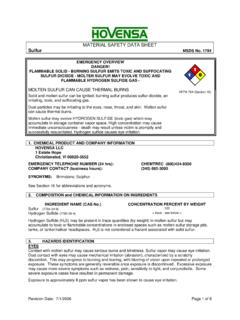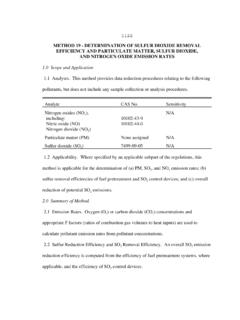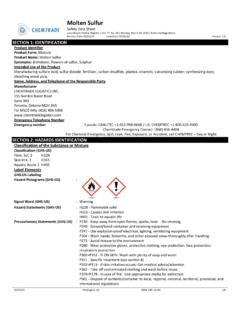Transcription of SULFUR CAS No.7704-34-9 - Sparchem
1 SULFUR CAS 1. Product Identification Synonyms: Colloidal SULFUR ; flowers of SULFUR ; precipitated SULFUR ; sublimed SULFUR ; brimstone CAS No.: 7704-34-9 Molecular Weight: Chemical Formula: S8 2. Composition/Information on Ingredients Ingredient CAS No Percent Hazardous --------------------------------------- ------------ ------------ --------- SULFUR 7704-34-9 100% Yes 3. Hazards Identification Emergency Overview -------------------------- WARNING!
2 FLAMMABLE SOLID. DUST MAY FORM FLAMMABLE OR EXPLOSIVE MIXTURE WITH AIR. MAY BE HARMFUL IF SWALLOWED OR INHALED. CAUSES EYE IRRITATION. MAY CAUSE IRRITATION TO SKIN AND RESPIRATORY TRACT. SAF-T-DATA(tm) Ratings (Provided here for your convenience) ---------------------------------------- ---------------------------------------- --------------------------- Health Rating: 1 - Slight (Life) Flammability Rating: 3 - Severe (Flammable) Reactivity Rating: 1 - Slight Contact Rating: 3 - Severe (Life) Lab Protective Equip: GOGGLES LAB COAT VENT HOOD; PROPER GLOVES Storage Color Code: Red (Flammable) ---------------------------------------- ---------------------------------------- --------------------------- Potential Health Effects ---------------------------------- Inhalation: Nuisance dust.
3 May cause coughing, sneezing or labored breathing if large amounts are inhaled. Ingestion: Considered essentially non-toxic by ingestion. Ingestion of very large amounts may cause sore throat, nausea, headache, and possibly unconsciousness in severe cases. May be converted into hydrogen sulfide in the intestine. Skin Contact: May cause irritation. Eye Contact: Irritant to human eyes at 6-8 ppm. Redness and pain may be observed. Chronic Exposure: Prolonged overexposure to SULFUR dust can produce possible skin sensitization and permanent eye damage(clouding of the lens and chronic irritation).
4 Prolonged inhalation can cause irritation of mucous membranes. Aggravation of Pre-existing Conditions: Sensitive individuals can experience skin irritation from repeated exposure to SULFUR dust. Allergenic responses can occur. 4. First Aid Measures Inhalation: Remove to fresh air. Get medical attention for any breathing difficulty. Ingestion: Induce vomiting immediately as directed by medical personnel. Never give anything by mouth to an unconscious person. Skin Contact: Wash exposed area with soap and water. Get medical advice if irritation develops. Eye Contact: Immediately flush eyes with plenty of water for at least 15 minutes, lifting lower and upper eyelids occasionally.
5 Get medical attention immediately. 5. Fire Fighting Measures Fire: Flash point: 207C (405F) OC Autoignition temperature: 232C (450F) Slight fire hazard when exposed to heat or flame. Explosion: Fine dust dispersed in air in sufficient concentrations, and in the presence of an ignition source is a potential dust explosion hazard. Explosive limits, dust in air, gm/cu meter: Lower - 35, Upper - 1400. Hazardous in contact with oxidizing materials; forms explosive mixtures. Fire Extinguishing Media: Use water spray to blanket fire, cool fire exposed containers, and to flush non-ignited spills or vapors away from fire.
6 Solid streams of water should not be used because of possibility of dispersing dust clouds of SULFUR in air. Special Information: In the event of a fire, wear full protective clothing and NIOSH-approved self-contained breathing apparatus with full facepiece operated in the pressure demand or other positive pressure mode. 6. Accidental Release Measures Remove all sources of ignition. Ventilate area of leak or spill. Wear appropriate personal protective equipment as specified in Section 8. Spills: Clean up spills in a manner that does not disperse dust into the air. Use non-sparking tools and equipment.
7 Reduce airborne dust and prevent scattering by moistening with water. Pick up spill for recovery or disposal and place in a closed container. 7. Handling and Storage Keep in a tightly closed container. Store in a cool, dry, corrosion-proof, ventilated area away from moisture, sources of heat or ignition, combustibles and oxidizers. Protect against physical damage. Avoid dust formation and control ignition sources. Employ grounding, venting and explosion relief provisions in accord with accepted engineering practices in any process capable of generating dust and/or static electricity.
8 Empty only into inert or non-flammable atmosphere. Emptying contents into a non-inert atmosphere where flammable vapors may be present could cause a flash fire or explosion due to electrostatic discharge. 8. Exposure Controls/Personal Protection Airborne Exposure Limits: None established. Ventilation System: In general, dilution ventilation is a satisfactory health hazard control for this substance. However, if conditions of use create discomfort to the worker, a local exhaust system should be considered. Personal Respirators (NIOSH Approved): For conditions of use where exposure to dust or mist is apparent and engineering controls are not feasible, a particulate respirator (NIOSH type N95 or better filters) may be worn.
9 If oil particles ( lubricants, cutting fluids, glycerine, etc.) are present, use a NIOSH type R or P filter. For emergencies or instances where the exposure levels are not known, use a full-face positive-pressure, air-supplied respirator. WARNING: Air-purifying respirators do not protect workers in oxygen-deficient atmospheres. Skin Protection: Wear protective gloves and clean body-covering clothing. Eye Protection: Use chemical safety goggles. Maintain eye wash fountain and quick-drench facilities in work area. Other Control Measures: Comments: Remove any worker from exposure to SULFUR who shows allergic reactions; such individual should not be assigned further work where exposed to SULFUR without a physician's approval.
10 9. Physical and Chemical Properties Appearance: Fine yellow powder. Odor: Faint odor. Solubility: Insoluble in water. Specific Gravity: at 20C (68F) pH: No information found. % Volatiles by volume @ 21C (70F): 0 Boiling Point: 445C (833F) Melting Point: 115C (239F) Vapor Density (Air=1): Vapor Pressure (mm Hg): 10 @ 246C (475F) Evaporation Rate (BuAc=1): No information found. 10. Stability and Reactivity Stability: Stable under ordinary conditions of use and storage. Transition temperature is about 95C (203F) (slow conversion) between alpha and beta crystalline forms.










